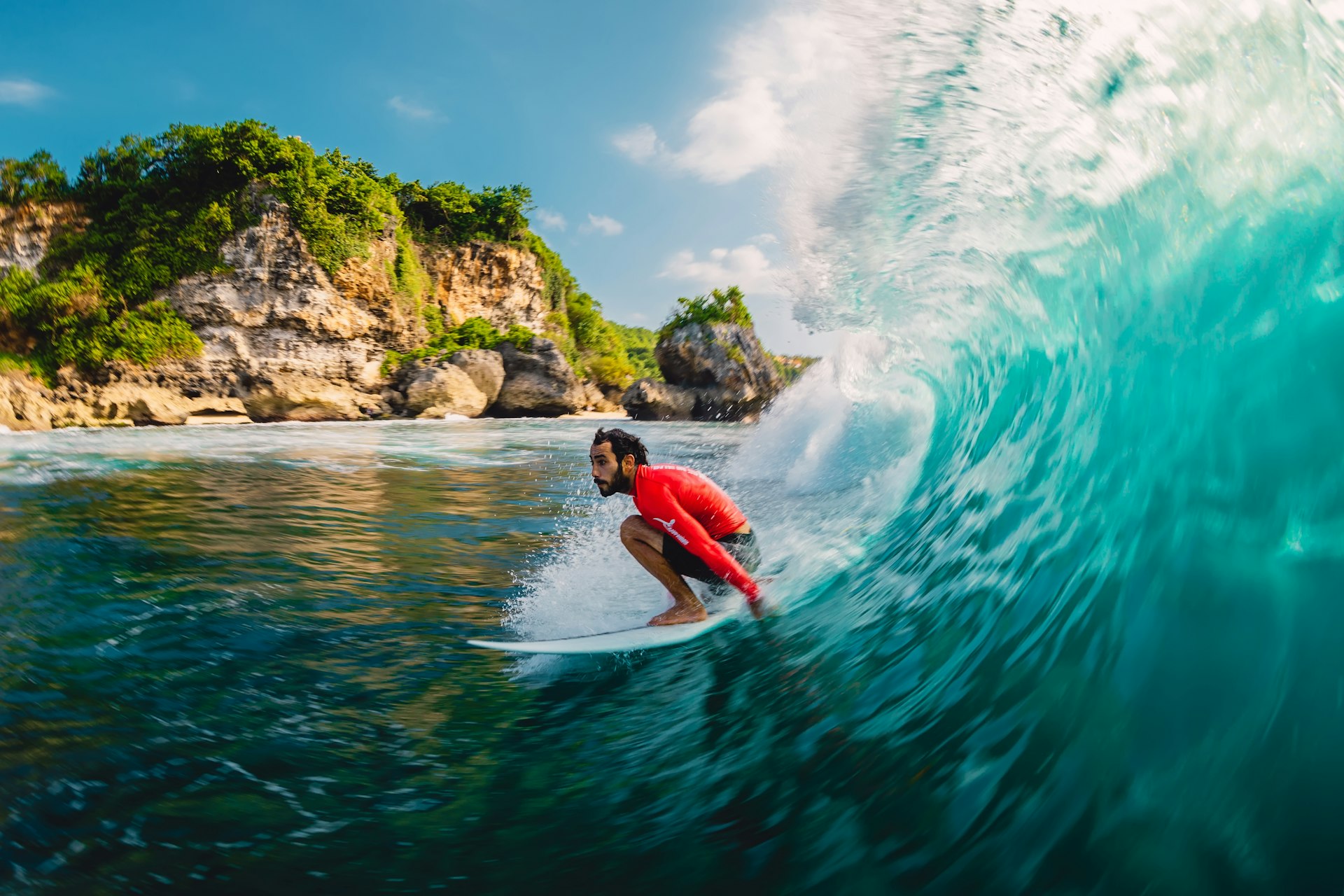Driving in Bali is not for the faint-hearted, but it does offer rewards. You can get off the beaten track and away from the crowds that besiege the southern highways, savoring soaring views over mountains and rice terraces, and pausing at simple roadside eateries for signature Indonesian meals of ikan bakar (grilled fish) and babi guling (suckling pig).
Whether you choose to drive yourself or hire a car and driver – a safe and increasingly popular option – a road trip in Bali will give you a sense of the island’s dramatic geography and rich culture that’s hard to come by from the back seat of a tour bus, let alone from Bali’s frustratingly limited public transport system.
To get the best from this beautiful island, here are five highly recommended routes for a Bali road trip.
1. Ubud Waterfalls Route
Best road trip for photographing rice terraces and waterfalls
Start and end – Ubud; 80km (50 miles); one day
Famed for its temples and crafts, Ubud in the age of Instagram is gaining attention for its many scenic waterfalls, including towering Tegenungan and canyon-framed Tukad Cepung, which looks amazing when photographed illuminated by rays of sunlight.
This satisfying one-day loop strings together rice field vistas and three of the most popular falls, plus the Ceking rice terraces in Tegalalang and the beautiful Gunung Kawi Sebatu water temple, a less-visited alternative to the more famous but less spectacular Tirta Empul sacred springs.
Local tip: Set out early in the morning so you have time for photo stops at the Tegenungan, Tibumana and Tukad Cepung falls, before veering north to Gunung Kawi Sebatu and south through the rice terrace landscapes around Tegalalang, then circling back to base.

2. East Bali Loop
Best road trip for hiking and snorkeling
Start and end – Candidasa or Padangbai; 130km (80 miles); two or more days
East Bali offers some of the island’s most dramatic landscapes, as well as slender but satisfying beaches where you can evade the crowds. Experience all of this on a leisurely multi-day loop that can take anything from two days to as long as you like.
Start either from the sweet little port town of Padangbai or the more developed tourist enclave of Candidasa and set out early to beat the crowds to Pura Lempuyang, a gorgeous complex of seven temples on the slopes of Mount Lempuyang. Rather than simply standing in line to photograph the Gates of Heaven – a Balinese open gateway that frames perfect views of the Agung volcano – it’s worth hiking all the way up to the top temple to enjoy the architecture, atmosphere and vistas.
Next, detour southwest via the historic water palace in scenic Tirta Gangga, enjoying lunch with a rice field view, then take the winding mountain road to the strip of fishing villages at Amed and spend at least one night by the shore. Be sure to dive or snorkel the USAT Liberty wreck, a hollowed-out World War II transport ship that now throngs with marine life such as sweetlips, trevally, bumphead parrot fish, crustaceans and sea turtles. Close the loop by following the pretty eastbound coastal road, stopping at the Taman Ujung water palace and other regal relics around Amlapura.
3. Around the Island
Best road trip for Bali’s famous beaches
Start and end – Sanur; 500km (310 miles); three days
Driving right around Bali is a time-consuming endeavor. With the main west coast road, a major inter-island trucking route and the main east coast route from Sanur to Padangbai one of the island’s few fast highways, it can also be both dangerous and stressful. But there are rewards for those who make the effort.
If you’re committed to the trip, start from the beach town of Sanur, head northeast, and then trace the north coast, go down the west coast, and circle around the Bukit Peninsula to get back to your starting point, allowing at least three days. En route, you can drop in on many of the island’s most famous – and busiest – surf beaches and shore temples, including Kuta Beach and Pura Tanah Lot.
Local tip: Traffic is generally slow, and journeys generally take much longer than Google Maps indicates.

4. South to North across Bali
Best road trip for Bali first-timers
Ubud–Singaraja; 80km (50 miles); two days
Driving across Bali from south to north is much easier than driving around Bali. Volcanoes, crater lakes, rice fields, temples and waterfalls offer ample rewards for landscape lovers and photographers. Start from Ubud (or farther south if that’s where you’re based) and follow the main cross-island route northwards towards Singaraja.
Stop in Bedugul for the world-class botanical gardens and the lakefront Pura Ulun Danu Bratan temple. Continue north via the towering Gitgit Waterfalls – waterfall addicts will want to hit the Sekumpul Falls as well – to Singaraja. After an afternoon exploring Singaraja, return the way you came the next morning.
Detour: If you want to extend your trip, head west along the attractive coast road to Taman Nasional Bali Barat (West Bali National Park) or Pemuteran Beach.
5. Nusa Penida Overnight
Best road trip for exploring caves
Start and end – Ped, Nusa Penida; 130km (80 miles); two days
Nusa Penida’s narrow cliffside roads offer some of Bali’s most scenic driving, and it’s worth spending a few days exploring this appealing island off Bali’s southeast coast. Spend one day investigating the southern and eastern sides of the island, stopping at the dramatic cave temple Goa Giri Putri, beautiful Diamond Beach, and Atuh Beach.
The next day, explore the more traveled northwest of Nusa Penida, snorkeling at Crystal Bay, photographing vertiginous Kelingking Beach, admiring the collapsed sea cave known as Broken Beach, and swimming in the natural infinity pool known as Angel’s Billabong.
Local tip: Wrap up with a sunset drink at the Amok Sunset bar on the northwest shore.

Tips for driving in Bali
Driving in Bali can be challenging. Expect to find yourself sharing the road with anything from dogs and chickens to kaki lima (street vendor) food carts, not to mention over-tired truckers, surging throngs of scooters and tourists who are as unfamiliar with local road etiquette as they are with the controls of their motorbikes. Road conditions vary widely, but even what passes for major roads may feature uneven surfaces and potholes marked (if you’re lucky) by a plastic bag waving from the end of a stick.
Driving in Bali is officially on the left, although you’ll see some creative approaches at junctions. It’s not uncommon for motorbikes to head the wrong way down the inside of a highway rather than attempt to turn across the traffic. Smaller vehicles are expected to move to make way for larger vehicles on the often narrow roads: never try to hold your position on the road against an oncoming truck.
As a general rule, driving in Bali is about managing what’s in front of you, rather than worrying about what’s behind. If driving without the correct papers, you will be expected to pay at the very least a cash bribe if stopped. Foreigners are vulnerable to exploitation after even a minor traffic accident, so drive cautiously and stick to the rules, even if locals don’t seem to.

Should I rent a scooter?
Rather than renting a car, many travelers follow locals’ lead and rent a scooter, which costs around 80,000–100,000Rp per day. Before considering this, keep in mind that your travel insurance will only cover you to drive if you have a valid motorbike license from your home country along with a valid international license or an Indonesian driver’s license.
Though it’s widely flouted, by law, both drivers and passengers must wear a helmet. Bali really isn’t the place to learn to ride a scooter – if you don’t already have a license, consider renting a small car instead.
Renting a car in Bali
A small entry-level rental car, with all damage covered at your own expense, can cost as little as 300,000Rp daily. However, renting from an international rental company with full insurance coverage – which is advisable – will cost considerably more. Renting a car with a driver can often work out cheaper than self-hire, costing around 700,000Rp per day. This will give you all the freedom of a Bali road trip without having to take the risk of driving yourself.

